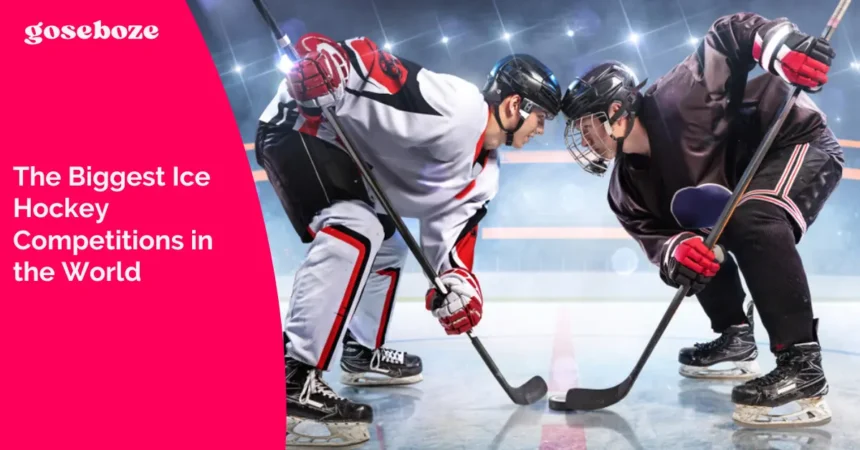Ice hockey is a world-recognized sport, but only its fans watch all of the modern tournaments. People who cheer for their national teams would be interested in the World Championships and National Hockey League. But hockey is more than just these gigantic leagues. Here, we speak about the biggest competitions in men’s and women’s hockey, indicating the historical contexts, tournament structures, and current champions.
World Championship
When the World Championship begins, it means that the world of hockey enthusiasts will take a pause in their everyday routine and stick to their TVs waiting for the event to start. The World Championship is an annual hockey tournament organized by the International Ice Hockey Federation that has happened yearly for over 104 years. This is truly the biggest ice hockey competition, attracting over 1.2 billion TV viewers. It starts in May and lasts for two weeks.
Tournament Structure
As the sports continued to grow each new year from its very beginning, more teams started to send requests to participate. So, today’s structure is the following:
- The modern format implies 16 teams in the main group and from three to four divisions of 12 teams.
- In total, a minimum of 52 teams take part in this tournament.
- The teams are divided into groups to play under the round-robin format.
Leading Teams
The teams below are listed according to the IIHF ranking system. This is a list of the top 10 leading ice hockey teams to participate in the World Championship. The scores for each are based on their placings over the last four years. It’s a convenient system with a clear formula that helps to determine teams into specific groups and divisions. So, here is it:
- Canada
- Finland
- Russia
- United States
- Germany
- Sweden
- Switzerland
- Czechia (current champion)
- Slovakia
- Latvia
National Hockey League (NHL) Stanley Cup Playoffs
NHL is an Ice Hockey Tournament League based in North America. 32 teams from the USA and Canada play for the biggest hockey trophy—the Stanley Cup. The tournament is organized by the National Hockey Association, which was founded in 1909 in Canada. However, today, the headquarters of the NHL are in New York, USA.
Tournament Structure
The NHL season begins at the end of September or late October. It is divided into the preseason, regular season, and postseason in April when the Steinley Cup playoff starts, the most awaited finals.
The entire tournament is divided into two conferences: Western and Eastern. Each conference has two divisions, each with 7 or 8 teams. In total, around 10 ones play over the season.
Read Also: The Most Prestigious Golf Tournaments Around the World: A Guide to the Majors
Stanley Cup Structure
Teams qualify for the Stanley Cup Playoffs. Each conference issues teams for the Playoffs that took the first, second, and third places. These teams are qualified automatically. However, two teams from each conference can also qualify for the Playoffs if they get the highest number of points during the season.
Leading Teams
We’ve listed the most valuable NHL teams, indicating their net worth. The statistics are taken from Forbes’ official magazine in 2023:
- Toronto Maple Leafs, worth US$2.8 billion
- New York Rangers, worth US$2.65 billion
- Montreal Canadiens, worth US$2.3 billion
- Los Angeles Kings, worth US$2 billion
- Boston Bruins, worth US$1.9 billion
Winter Olympic Games
This year is the anniversary of hockey’s appearance at the Winter Olympics. Exactly 100 years ago, the first tournament was held at the Winter Olympic Games in France. Since then, people have been watching the tournament matches every four years. Since 1998, women’s teams have appeared.
Tournament Structure
The Big “Six”, including Canada, the USA, Finland, Russia, Sweden, and the Czech Republic, have been passing qualification automatically since 1998 and were allowed to enter the finals of a round-robin format. After that, the qualification was based on the IICF World Ranking.
Leading Nations
The team rank is based on the number of medals since 1924. The table below demonstrates the number of gold, silver, and bronze medals for each nation and their ranks. If you are looking for the next Winter Olympic ice hockey candidates and their odds, check here!
| Nation | Gold 🥇 | Silver 🥈 | Bronze🥉 |
| Canada | 9 | 4 | 3 |
| Russia | 9 | 3 | 2 |
| USA | 2 | 8 | 1 |
| Sweden | 2 | 3 | 4 |
| Czech Republic | 1 | 4 | 5 |
| Finland | 1 | 2 | 4 |
World Junior Ice Hockey Championship
World Junior (WJC) is an annual tournament for under-20 hockey teams organized by IIHF. From December to January it attracts only top hockey players from this age category. Officially, the first season started in 1977. The Soviet Union, Russia then, and Canada dominated strongly with 13 and 20 gold medals respectively. Although the current winner is the United States (it is their sixth title).
Tournament Structure
The top teams (champions) form the “Top Division.” Then, they are spread among divisions one, two, and three. Each division (pool) consists of teams that have a chance to be relegated or promoted to higher or lower divisions.
Leading Nations
Canada is an unbeatable champion by the number of gold medals (20) it has won in the World Junior Ice Hockey Championship. Russia (Soviet Union and CIS) takes second place with 13 gold medals. The achievements of unofficial tournaments are not included in the statistics.
Women’s Ice Hockey World Championships
Now let’s explore another IIHF tournament, but for women only. There were numerous arguments about women’s hockey during the 20th century, which is why the first official competition was held only in 1990. Before that, female hockey players struggled to organize tournaments on a worldwide scale. The tournament’s origins are located in Canada and the USA; thus, these nations are leaders in women’s hockey.
Tournament Structure
The structure is similar to men’s tournaments with a “Top Division” and a lower division. The first qualification system was based on the results of the 1989 European Championships for Women and the Asian system. Nowadays, the structure is the following:
- Ten teams are divided into two groups to play round-robin.
- Five teams from Group A and three teams from Group B go to the quarterfinals.
- Starting with the 2025 year, four teams from each group will go to the quarterfinals.
- The other two teams enter the knockout stage.
Leading Nations
Since not all nations can afford to form women’s national hockey teams, the United States is the first nation by the number of appearances and wins. They have the most points, goals and other crucial indicators. Based on the latest five-year performance, we could only see Canada and the USA in the finals. Unfortunately, European teams will need some time to compete in this fierce competition properly. What’s the rank today?
- United States
- Canada
- Finland
- Sweden
- Germany
- Russia
American Hockey League (AHL) Calder Cup Playoffs
Calder Cup is the greatest American Hockey League award for postseason Playoffs winners. AHL is a developmental or minor league for the NHL League. It’s based in the USA and Canada and consists of 32 teams.
All of the teams from the NHL were affiliated with an AHL team. Only 6 of the 32 teams are from Canada. The rest are from the United States. To play in the AHL, you must be 18 years old or older and do not belong to the Junior team.
Calder Cup Playoff Tournament Structure
Four teams from each division will play best-of-five under the division series of semifinals. Then, once they enter the playoffs, they start another best-of-five series in the division finals and the best-of-seven in the conference and playoff finals. The winner takes the Calder Cup. The tournament structure looks like this:
- First round
- Division semifinals
- Division finals
- Conference finals
- Calder Cup finals
Spengler Cup
Spengler Cup is one of the pioneer Ice Hockey tournaments held in Switzerland. Teams from all over Europe and North America are invited to the tournament annually. Hockey Club Davos, the home club, is the event host and, along with Team Canada, the owner of the most Spengler Cup titles.
Tournament Structure
Qualification is preceded through invitations only. It does not have to be national teams only. Teams can be formed of different players from different countries. The event takes place at Eisstadion Davos in December,
Leading Teams
The home team, Davos, and Team Canada are the leaders by their performance at all times, including the winning and runner-up statistics. After that, you can witness two teams from the Czech Republic, LTC Prague, and Dukla Jihlava. Currently, the top teams are the following:
- HC Davos – Swiss
- HC Ambrì-Piotta – Swiss
- Dynamo Pardubice – Czech Republic
- Sparta Prague – Czech Republic
- Team Canada – Canada
- HC Oceláři Třinec – Czech Republic
- KalPa Kuopio – Finland
Ontario Hockey League (OHL)
This is the biggest Canadian hockey league for juniors, featuring mostly clubs from Canada and a few from the States. The average age of players is 16 to 20, indicating its focus on forming professionals for higher leagues. It starts in the third week of September and runs until the end of March.
Tournament Structure
Since most players are school members, the match days are spread over the weekends to minimize the missed school days. Around 20% of active NHL players started their professional careers at OHL, which is a great result of the lower league. The Ontario Hockey League is grouped into 20 teams, but only 16 teams, 8 from each conference, end up being in the playoffs. All teams play the best of seven, and two finalists compete for the J. Ross Robertson Cup.
Leading Teams
The list below includes the latest champions and owners of the J. Ross Robertson Cup. The first memorial cup was awarded in 1918, and since then, teams have been awarded this memorial cup annually. The following teams were lucky and strong enough to get the final prize:
- London Knights
- Peterborough Petes
- Hamilton Bulldogs
- Guelph Storm
- Erie Otters
Conclusion
Ice hockey as a sport has a tremendous history. Millions of matches were held during the history of ice hockey tournaments, such as the World Championship, NHL, Olympic Games, Junior and Women’s Championships, as well as national competitions in Canada, the USA, and Europe.








